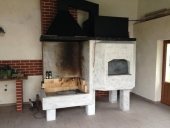posted 8 years ago
Mixing in the old bath i found using a spade or shovel was too much hard work ,biocrete needs to be handled like hay or muck , with a pitchfork , mines an old 4 tine and this makes the process much easier to churn and lift into the tubs as well , i first mixed the water and binder into a slurry ,mashing any lumps smooth ---heres where a drill mounted mortar mix blade would help , then i would add the grass in a bucket at a time, surprisingly over mixing even by hand can be done ,which results in the lime binder separating and to start balling up instead of staying coated onto the grass . The recipe i settled on was gleaned from some studies done in sweden , 19% binder 31% grass 50% water by weight of what ever amount you mix , the binder is made from 2 parts hydrated lime and 1 part hydraulic lime---mine is NHL5 purely because thats what i have to hand , but i will be trying out some NHL3 . The study done substituted some of the binder with flyash about 5% of the total mix by weight. I did try some ash from my wood/turf burning stove as an added ingredient but not as a part substitute for the binder in 2 batches , both did set up but i cant prove in any definite way if for better or quicker, and i cant see the point in using it for my purposes , i only produce about half a bucket of ash per day at most usually less. There is a large coal burning power generating plant about 30 min drive away they supply to several cement producing plants, but flyash from coal is considered a heavy metal contaminant waste material and you require a permit of sorts to handle and transport it ---so i wont be going to the added expense or trouble for my small scale
mgrassbuild-008.JPG
![Filename: mgrassbuild-008.JPG
Description: [Thumbnail for mgrassbuild-008.JPG]](/t/68461/a/52955/mgrassbuild-008.JPG)

 6
6




 1
1
















 1
1




 1
1

















